

Psychoneuroimmunology. Psychoneuroimmunology (PNI), also referred to as psychoendoneuroimmunology (PENI) or psychoneuroendocrinoimmunology (PNEI), is the study of the interaction between psychological processes and the nervous and immune systems of the human body.[1][2] PNI takes an interdisciplinary approach, incorporating psychology, neuroscience, immunology, physiology, genetics, pharmacology, molecular biology, psychiatry, behavioral medicine, infectious diseases, endocrinology, and rheumatology.
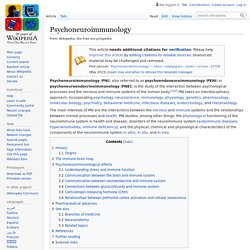
The main interests of PNI are the interactions between the nervous and immune systems and the relationships between mental processes and health. The Role of Infections in Mental Illness. By Frank Strick, Clinical Research Director (The Research Institute for Infectious Mental Illness is no longer open.).

In considering an infectious etiology to any chronic mental illness there are at least four categories to consider. First are those infections already recognized to induce psychiatric symptoms. These include pneumonia, urinary tract infection, sepsis, malaria, Legionnaire’s disease, syphilis, typhoid, diphtheria, HIV, rheumatic fever and herpes. (Ref: Chuang) While the psychiatric effects of these infections are known to the medical field, they are rarely screened for if the initial presentation is made to a mental health professional. The Michael J. Fox Foundation for Parkinson's Research. Depression in Adults with a Chronic Physical Health Problem: Treatment and Management. Hypokinesia. Hypokinesia refers to decreased bodily movement.[1] One of the two categories of movement disorders, hypokinesia is characterized by a partial or complete loss of muscle movement due to a disruption in the basal ganglia.
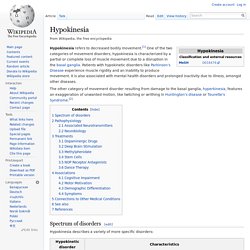
Patients with hypokinetic disorders like Parkinson’s Disease experience muscle rigidity and an inability to produce movement. It is also associated with mental health disorders and prolonged inactivity due to illness, amongst other diseases. The other category of movement disorder resulting from damage to the basal ganglia, hyperkinesia, features an exaggeration of unwanted motion, like twitching or writhing in Huntington’s disease or Tourette's Syndrome.[2] Spectrum of disorders[edit] Hypokinesia describes a variety of more specific disorders: A person with medication-induced dystonia Pathophysiology[edit] Associated Neurotransmitters[edit] Dopamine GABA and Glutamate GABA and glutamate often interact with each other and with dopamine directly.
Neurobiology[edit] Gender. List of regions in the human brain. Anatomical regions of the brain are listed vertically, following hierarchies that are standard in neuroanatomy.
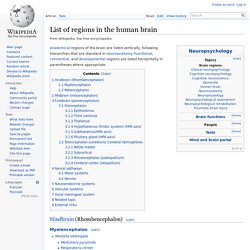
Functional, connective, and developmental regions are listed horizontally in parentheses where appropriate. Hindbrain (Rhombencephalon)[edit] Myelencephalon[edit] Metencephalon[edit] Midbrain (mesencephalon)[edit] Forebrain (prosencephalon)[edit] Progress through collaboration. Psychosomatica. Welcome to Ergoweb - The Place for Ergonomics.
Alexander technique. The Alexander technique, named after Frederick Matthias Alexander, teaches people how to stop using unnecessary levels of muscular and mental tension during their everyday activities.
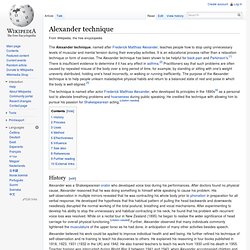
It is an educational process rather than a relaxation technique or form of exercise. The Alexander technique has been shown to be helpful for back pain and Parkinson's.[1] There is insufficient evidence to determine if it has any effect in asthma.[2] Practitioners say that such problems are often caused by repeated misuse of the body over a long period of time, for example, by standing or sitting with one's weight unevenly distributed, holding one's head incorrectly, or walking or running inefficiently. The purpose of the Alexander technique is to help people unlearn maladaptive physical habits and return to a balanced state of rest and poise in which the body is well-aligned.[3] History[edit] Alexander was a Shakespearean orator who developed voice loss during his performances.
Process[edit] End-gaining. Eft-meridian-info. The Advantages of Using the 9 Gamut Procedure - EFT Masters. By Mair Llewellyn, EFT Master Introduction I really wanted to write this article because I discovered the advantages of using the 9 Gamut Procedure.

I realize that most practitioners (myself included) don’t use it much because the shortcut version of The Basic Recipe usually does the job. However, there are times when it can be quite useful. In this article I will first discuss some of the disadvantages of using the 9 Gamut Procedure. Meridian Tapping - The 9-Gamut Procedure. Anyone who has ever done EFT knows that it looks a little silly.
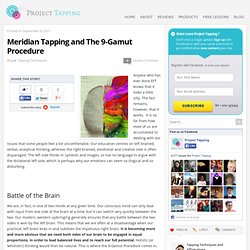
The fact remains, however, that it works. It is so far from how most of us are accustomed to dealing with our issues that some people feel a bit uncomfortable. Our education centres on left brained, verbal, analytical thinking, whereas the right brained, emotional and creative side is often disparaged. The left side thinks in symbols and images, so has no language to argue with the dictatorial left side, which is perhaps why our emotions can seem so illogical and so disturbing. Battle of the Brain We are, in fact, in one of two minds at any given time.
The 9-Gamut procedure looks even sillier than the tapping sequence and has not had much attention lately, but it has a very useful function. The 9 Gamut In a Nutshell Start with a round of tapping in the usual way. Repeat a round of tapping. The first time I did this I felt completely daft, until I realized what was happening. Emotional Freedom Technique (EFT) - Emotional Health.